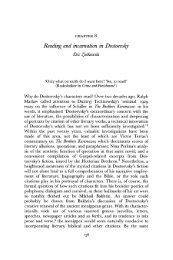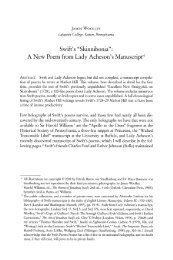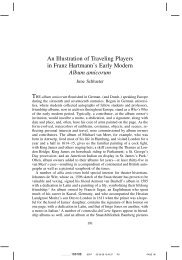courses of instruction - Lafayette College
courses of instruction - Lafayette College
courses of instruction - Lafayette College
Create successful ePaper yourself
Turn your PDF publications into a flip-book with our unique Google optimized e-Paper software.
CIVIL AND ENVIRONMENTAL<br />
ENGINEERING<br />
Pr<strong>of</strong>essor McGhee, Head; Pr<strong>of</strong>essor Viscomi;<br />
Associate Pr<strong>of</strong>essors Roth, Ruggles, and<br />
Veshosky; Assistant Pr<strong>of</strong>essors Boile, Ereger,<br />
Driver, and Saliklis<br />
Civil engineers, like all engineers, are<br />
problem-solvers. They find the best ways<br />
to construct bridges, buildings, dams, and<br />
highways. They design water plants and<br />
waste treatment systems, and look for<br />
ways to manage hazardous materials.<br />
The curriculum prepares students for a<br />
variety <strong>of</strong> situations by emphasizing fun<br />
damental principles <strong>of</strong> engineering, an ap<br />
preciation <strong>of</strong> the effect <strong>of</strong> human factors<br />
on technology, logical thinking, resource<br />
fulness, and ethical considerations in ap<br />
plying science to human problems. In ad<br />
dition to a thorough grounding in science<br />
and technology, students select more than<br />
one-fifth <strong>of</strong> their <strong>courses</strong> in the liberal arts<br />
and humanities.<br />
Majors may choose to focus on environ<br />
mental or structural engineering or other<br />
areas <strong>of</strong> interest. Laboratories include ma<br />
terials testing, fluid mechanics, geotechni-<br />
cal engineering, environmental engineer<br />
ing, and advanced microcomputers.<br />
Requirements for the major: Majors are<br />
required to take Mathematics 161,162,<br />
263, and 264; Physics 131; Chemistry 121;<br />
Engineering Science 101,225,226, and 230;<br />
either Chemistry 122 or Engineering Sci<br />
ence 231; Civil and Environmental Engi<br />
neering 221,251,271, 301, 311, 331, 341,<br />
361, 372, 473 and four departmental elec-<br />
tives; eight <strong>courses</strong> chosen from an<br />
approved list <strong>of</strong> humanities and social sci<br />
ences including a First-Year Seminar and<br />
English 110; a science or mathematics elec<br />
tive; two technical electives (upper-level<br />
mathematics, science, or engineering<br />
<strong>courses</strong>, usually requiring one or more<br />
prerequisites); and two free electives.<br />
REQUIRED COURSES<br />
221. Environmental Engineering. The<br />
application <strong>of</strong> engineering principles to a<br />
variety <strong>of</strong> environmental problems. Topics<br />
ENGINEERING/CIVIL AND ENVIRONMENTAL<br />
to be considered include population and<br />
energy growth, water supply and pollu<br />
tion control, air and noise pollution, solid<br />
and hazardous wastes, and environmental<br />
management. Laboratories consist <strong>of</strong><br />
computer modeling <strong>of</strong> environmental<br />
problems, sample collection, and chemical<br />
analysis methods. Students complete a<br />
term paper on an environmental issue<br />
<strong>of</strong> their choosing. Lecture/laboratory.<br />
Prerequisites: Mathematics 162; Chemis<br />
try 122 or ES 231, or permission <strong>of</strong> instruc<br />
tor. Offered in fall semester. Staff<br />
251. Fluid Mechanics. Basic principles <strong>of</strong><br />
fluid mechanics. Fluid properties; hydro<br />
statics; fluid flow concepts including con<br />
tinuity, energy, and momentum; and di<br />
mensional analysis are covered. Applica<br />
tions include open channel flow, pipe sys<br />
tems, hydraulic models, hydraulic<br />
machinery, and fluid flow measurement.<br />
Lecture /laboratory. Prerequisite: ES 210.<br />
Offered in spring semester. Staff<br />
271. Design I. An introductory course in<br />
engineering design and measurement.<br />
Topics include fundamentals <strong>of</strong> surveying,<br />
statistical analysis, project management,<br />
and technical writing all <strong>of</strong> which are ap<br />
plied throughout the course in a series <strong>of</strong><br />
design projects. Laboratory work includes<br />
surveying field work, CAD, project man<br />
agement, and CAD-based civil engineer<br />
ing applications. Lecture/laboratory.<br />
Prerequisites: Mathematics 161,162;<br />
and ES 101. Offered in fall semester. S taff<br />
301. Risk Assessment. A quantitative ap<br />
proach for analyzing and managing risk in<br />
engineering problems and design. Pro<br />
vides a foundation in probability and sta<br />
tistics related to civil engineering and ex<br />
tends this to analysis <strong>of</strong> data, identifica<br />
tion and analysis <strong>of</strong> risk in engineering de<br />
sign, and determination <strong>of</strong> acceptable risk<br />
and methods for risk management. Topics<br />
and applications include reliability engi<br />
neering, safety engineering, environmen<br />
tal risk management, and exposure to the<br />
surrounding economic, regulatory, and<br />
ethical issues. Staff<br />
91











